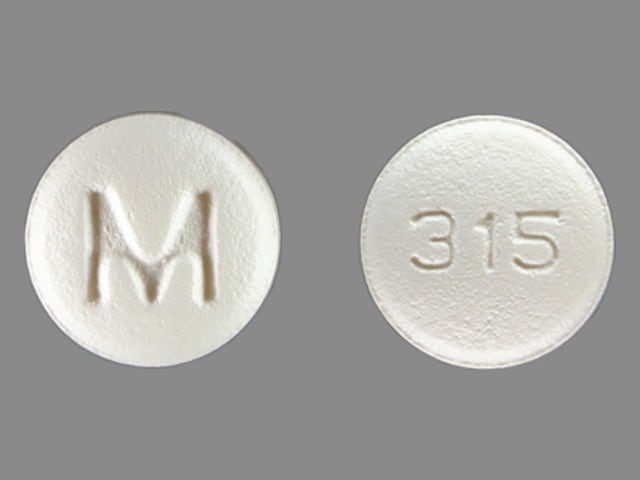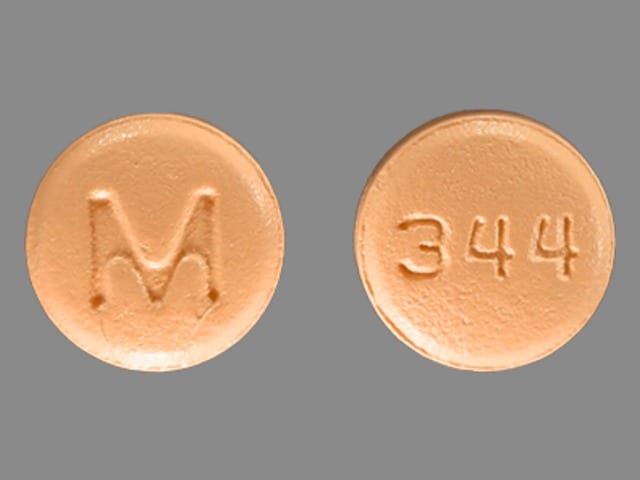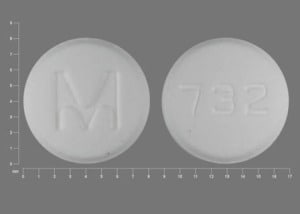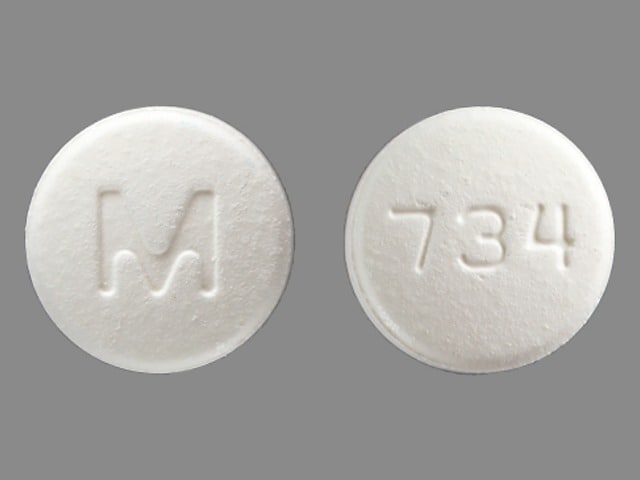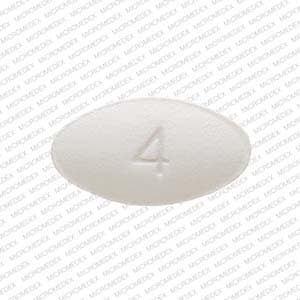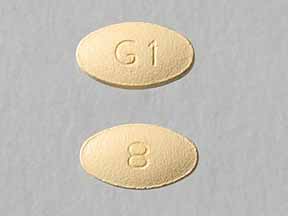Dosage Forms
Excipient information presented when available (limited, particularly for generics); consult specific product labeling. [DSC] = Discontinued product
Film, Oral:
Zuplenz: 4 mg (1 ea [DSC], 10 ea [DSC], 30 ea); 8 mg (1 ea [DSC], 10 ea [DSC], 30 ea)
Solution, Injection, as hydrochloride [strength expressed as base]:
Generic: 4 mg/2 mL (2 mL); 40 mg/20 mL (20 mL)
Solution, Injection, as hydrochloride [strength expressed as base, preservative free]:
Generic: 4 mg/2 mL (2 mL)
Solution, Oral, as hydrochloride [strength expressed as base]:
Zofran: 4 mg/5 mL (50 mL [DSC]) [strawberry flavor]
Generic: 4 mg/5 mL (50 mL)
Tablet, Oral, as hydrochloride [strength expressed as base]:
Zofran: 4 mg, 8 mg
Generic: 4 mg, 8 mg, 24 mg
Tablet Disintegrating, Oral:
Zofran ODT: 4 mg [DSC], 8 mg [DSC] [contains aspartame, methylparaben sodium, propylparaben sodium; strawberry flavor]
Generic: 4 mg, 8 mg
Pharmacology
Mechanism of Action
Ondansetron is a selective 5-HT3-receptor antagonist which blocks serotonin, both peripherally on vagal nerve terminals and centrally in the chemoreceptor trigger zone
Pharmacokinetics/Pharmacodynamics
Absorption
Oral: 100%; nonlinear absorption occurs with increasing oral doses; Zofran ODT tablets are bioequivalent to Zofran tablets; absorption does not occur via oral mucosa
Distribution
Vd:
Infants and Children: Surgical patients:
1 to 4 months: 3.5 L/kg
5 to 24 months: 2.3 L/kg
3 to 12 years: 1.65 L/kg
Children and Adolescents: Cancer patients: 4 to 18 years: 1.9 L/kg
Adults: 1.9 L/kg
Metabolism
Extensively hepatic via hydroxylation, followed by glucuronide or sulfate conjugation; CYP1A2, CYP2D6, and CYP3A4 substrate, some demethylation occurs
Excretion
Urine (44% to 60% as metabolites, ~5% as unchanged drug); feces (~25%)
Clearance:
Cancer patients: Children and Adolescents 4 to 18 years: 0.599 L/kg/hour
Surgical patients: Infants and Children: 1 to 4 months: 0.401 L/kg/hour; 5 to 24 months: 0.581 L/kg/hour; 3 to 12 years: 0.439 L/kg/hour
Adult (normal): 19 to 40 years: 0.381 L/kg/hour; 61 to 74 years: 0.319 L/kg/hour; >75 years: 0.262 L/kg/hour
Onset of Action
~30 minutes
Time to Peak
Oral: ~2 hours; Oral soluble film: ~1 hour
Half-Life Elimination
Children:
Cancer patients: Children and Adolescents: 4 to 18 years: 2.8 hours
Surgical patients: Infants 1 to 4 months: 6.7 hours; Infants and Children 5 months to 12 years: 2.9 hours
Adults: 3 to 6 hours; Mild-to-moderate hepatic impairment (Child-Pugh classes A and B): 12 hours; Severe hepatic impairment (Child-Pugh class C): 20 hours
Protein Binding
Plasma: 70% to 76%
Use in Specific Populations
Special Populations: Renal Function Impairment
Mean plasma clearance is reduced by 41% (IV) and 50% (oral) in patients with severe renal impairment (CrCl <30 mL/minute).
Special Populations: Hepatic Function Impairment
Clearance is reduced 2- to 3-fold and the volume of distribution is increased. The half-life is increased to 20 hours in patients with severe hepatic impairment.
Special Populations: Elderly
In elderly patients >75 years of age, there is a reduction in clearance and an increase in elimination half-life.
Special Populations: Gender
The extent and rate of absorption is greater in women than in men. There is slower clearance, a smaller volume of distribution, and higher bioavailability in women.
Use: Labeled Indications
Cancer chemotherapy-induced nausea and vomiting:
IV: Prevention of nausea and vomiting associated with initial and repeat courses of emetogenic cancer chemotherapy (including high-dose cisplatin).
Oral:
Prevention of nausea and vomiting associated with highly emetogenic cancer chemotherapy (including cisplatin ≥50 mg/m2).
Prevention of nausea and vomiting associated with initial and repeat courses of moderately emetogenic cancer chemotherapy.
Postoperative nausea and/or vomiting: IV, IM, Oral: Prevention of postoperative nausea and/or vomiting (PONV). If nausea/vomiting occur in a patient who had not received prophylactic ondansetron, IV ondansetron may be administered to prevent further episodes.
Limitations of use: Routine prophylaxis for PONV in patients with minimal expectation of nausea and/or vomiting is not recommended, although use is recommended in patients when nausea and vomiting must be avoided in the postoperative period, even if the incidence of PONV is low.
Radiotherapy-associated nausea and vomiting: Oral: Prevention of nausea and vomiting associated with radiotherapy in patients receiving either total body irradiation, single high-dose fraction to the abdomen, or daily fractions to the abdomen.
Use: Off Label
Carcinoid syndrome-associated diarrhea, severe, refractoryc
Data from a limited number of patients (case reports) suggest that ondansetron may be of benefit in the management of severe carcinoid syndrome associated-diarrhea that is refractory to preferred agents (eg, somatostatin analogues) Kiesewetter 2013, Platt 1992, Schwörer 1995, Wymenga 1998.
Gastroparesis, symptomatic treatment of nausea and vomiting (alternative agent in patients with persistent symptoms refractory to prokinetic therapy)c
Expert opinion suggests the utility of ondansetron as an alternative agent in patients with persistent nausea and vomiting refractory to prokinetic therapy ACG [Camilleri 2013], Camilleri 2018. There are no published data evaluating the role of antiemetics, including ondansetron, in the treatment of this condition.
Nausea and/or vomiting, acute, severec
Limited data from a small number of randomized and nonrandomized trials, primarily in the emergency department setting, suggest benefit with ondansetron in the treatment of severe, acute undifferentiated nausea and/or vomiting Barrett 2011, Braude 2008, Egerton-Warburton 2014, Patka 2011, Salvucci 2011; however, definitive, high-quality trials supporting efficacy are lacking Furyk 2015.
Clinical experience also suggests the utility of ondansetron in the treatment of severe, acute nausea and vomiting due to a variety of self-limiting etiologies such as viral gastroenteritis Alexandraki 2019, acute mountain sickness Gallagher 2018, or a variety of other medical conditions associated with severe nausea/vomiting.
Postoperative nausea and vomiting, treatment or rescue therapyyes
Based on the Society for Ambulatory Anesthesia guidelines for the management of postoperative nausea, it is reasonable to administer a 5-HT3 receptor antagonist for the treatment of postoperative nausea and vomiting when a prophylactic agent was not utilized or as rescue therapy when an agent from a different class was utilized as prophylaxis and failed.
Pregnancy-associated nausea and vomiting, severe or refractorybyes
Based on the Society of Obstetricians and Gynaecologists of Canada guideline on nausea and vomiting of pregnancy and the American College of Obstetricians and Gynecologists practice bulletin, the use of ondansetron may be considered in the treatment of severe or refractory nausea and vomiting when preferred agents have failed ACOG 2018, Arsenault 2002.
Vertigo-associated nausea and vomitingc
Data from a small, open-label, pilot study and clinical experience suggests the utility of ondansetron in the acute treatment of nausea and vomiting associated with vertigo Furman 2018, Rice 1995.
Contraindications
Hypersensitivity to ondansetron or any component of the formulation; concomitant use with apomorphine
Dosage and Administration
Dosing: Adult
Note: Single IV doses >16 mg are no longer recommended due to the potential for QT prolongation (FDA 2012).
Carcinoid syndrome-associated diarrhea, severe, refractory (alternative agent) (off-label use): Based on limited data (case reports):
Oral: 8 mg 3 times daily (Wymenga 1998) or 8 mg twice daily for 3 days, followed by a maintenance dose of 4 to 8 mg/day for 4 to 12 weeks (Kiesewetter 2013).
IV: 4 to 8 mg every 8 hours (Schwörer 1995).
Chemotherapy-induced nausea and vomiting, prevention: Single-day IV chemotherapy regimens:
Highly emetogenic chemotherapy (>90% risk of emesis [eg, cisplatin, breast cancer regimens that include an anthracycline combined with cyclophosphamide]):
Day of chemotherapy: Administer prior to chemotherapy and in combination with a neurokinin 1 (NK1) receptor antagonist, dexamethasone, with or without olanzapine (ASCO [Hesketh 2017]; MASCC/ESMO [Roila 2016]).
IV: 8 mg or 0.15 mg/kg (maximum: 16 mg/dose) as a single dose (manufacturer's labeling).
Oral:
All oral formulations except for the oral soluble film: 8 mg twice daily for 2 doses with the first dose administered prior to chemotherapy administration.
Manufacturer's labeling: Dosing in the prescribing information may not reflect current clinical practice: 24 mg as a single dose.
Oral soluble film: 24 mg (three 8 mg doses given together) as a single dose.
Postchemotherapy days: 5-HT3 receptor antagonist use is not recommended (alternative agents are recommended) (ASCO [Hesketh 2017]; MASCC/ESMO [Roila 2016]).
Moderately emetogenic chemotherapy (30% to 90% risk of emesis): Carboplatin-based regimens:
Day of chemotherapy: Administer prior to chemotherapy and in combination with an NK1 receptor antagonist and dexamethasone (ASCO [Hesketh 2017]; MASCC/ESMO [Roila 2016]).
IV: 8 mg or 0.15 mg/kg (maximum: 16 mg/dose) as a single dose (manufacturer's labeling).
Oral: 8 mg twice daily for 2 doses with the first dose administered prior to chemotherapy administration (manufacturer's labeling).
Postchemotherapy days: Antiemetic use is not necessary (ASCO [Hesketh 2017]; MASCC/ESMO [Roila 2016]).
Moderately emetogenic chemotherapy (30% to 90% risk of emesis): Non-carboplatin-based regimens (alternative agent):
Note: ASCO guidelines and MASCC/ESMO guidelines do not state a preference for which 5-HT3 receptor antagonist should be used in this setting; however, some experts recommend palonosetron as the preferred 5-HT3 receptor antagonist (Celio 2015; Hesketh 2018; Popovic 2014).
Day of chemotherapy: Administer prior to chemotherapy and in combination with dexamethasone (ASCO [Hesketh 2017]; MASCC/ESMO [Roila 2016]).
IV: 8 mg or 0.15 mg/kg (maximum: 16 mg/dose) as a single dose (manufacturer's labeling).
Oral: 8 mg twice daily for 2 doses with the first dose administered prior to chemotherapy administration (manufacturer's labeling).
Postchemotherapy days: 5-HT3 receptor antagonist use is not recommended (alternative agents, depending on the chemotherapy regimen administered, may be recommended) (ASCO [Hesketh 2017]; MASCC/ESMO [Roila 2016]); however, if a first-generation 5-HT3 receptor antagonist (eg, ondansetron, granisetron) was used on day 1 of chemotherapy rather than palonosetron, some experts suggest the first-generation 5-HT3 receptor antagonist be continued for postchemotherapy emetic prophylaxis on days 2 and 3 (Hesketh 2018).
Low emetogenic risk (10% to 30% risk of emesis):
Note: Single-agent ondansetron is one of many options for prophylaxis (ASCO [Hesketh 2017; MASCC/ESMO [Roila 2016]).
Day of chemotherapy: Administer as a single dose prior to chemotherapy (ASCO [Hesketh 2017]).
IV: 8 mg or 0.15 mg/kg (maximum: 16 mg/dose) (ASCO [Hesketh 2017]; manufacturer's labeling).
Oral (off-label): 8 mg (ASCO [Hesketh 2017]).
Postchemotherapy days: Prophylaxis is not necessary on subsequent days (ASCO [Hesketh 2017]; MASCC/ESMO [Roila 2016]).
Chemotherapy-induced nausea and vomiting, prevention: Oral chemotherapy agents: Limited data; based on expert opinion:
High/moderate emetogenic risk oral agent: Oral: 8 to 16 mg/day administered before chemotherapy and continued daily (Hesketh 2018).
Low/minimal emetogenic risk oral agent: Oral: 8 to 16 mg/day on an as-needed basis (Hesketh 2018).
Gastroparesis, symptomatic treatment of nausea and vomiting (alternative agent) (off-label use):
Note: For patients with persistent symptoms refractory to prokinetic therapy. No data available; recommendations for use and dose are based on expert opinion.
Oral: 4 to 8 mg 3 times daily (ACG [Camilleri 2013]; Camilleri 2018).
Nausea and/or vomiting, acute, severe (off-label use):
Note: Use has primarily been evaluated in patients with undifferentiated nausea/vomiting presenting to the emergency department; however, may also use for nausea/vomiting due to viral gastroenteritis, acute mountain sickness, and a variety of other medical conditions associated with severe, self-limiting acute nausea/vomiting (Alexandraki 2019; Gallagher 2018).
Oral, IV, IM: 4 mg as a single dose (Barrett 2011; Braude 2008; Egerton-Warburton 2014; Patanwala 2010; Patka 2011; Salvucci 2011). Note: For parenteral therapy, IV administration is preferred over IM when possible (Salvucci 2011).
Prevention of vomiting (and associated increase in intraocular pressure) in patients with eye trauma: IV: 4 to 8 mg as a single dose (Andreoli 2019).
Postoperative nausea and vomiting, prevention:
Moderate- to high-risk patients:
Note: In patients at moderate risk, may combine ondansetron with other prophylactic interventions (eg, another antiemetic agent from a different pharmacologic class, modification of anesthetic technique, acupuncture); in patients at high risk, combine 3 or more interventions (Apfel 2004; Feinleib 2018; Gan 2014).
Usual dose: IV: 4 mg as a single dose at the end of surgery (Gan 2014).
Alternative strategy: Oral (oral disintegrating tablet or oral soluble film): 8 mg as a single dose given 30 to 60 minutes prior to surgery (Gan 2014; Grover 2009; Kenny 1992).
Low-risk patients:Although prophylaxis is not always indicated in low-risk patients, consensus guidelines acknowledge that some experts may administer an antiemetic in these patients; however, clinicians are also advised that this strategy comes with the potentially unnecessary risk of rare adverse effects (Gan 2014). If ondansetron is given, the dosing is the same as for moderate- to high-risk patients.
Postdischarge management in high-risk patients: Limited data available; dosage regimen studied in a single clinical trial: Oral (oral disintegrating tablet or oral soluble film): 8 mg to be taken on discharge and in the morning of postoperative days 1 and 2 (Pan 2008).
Postoperative nausea and vomiting, treatment or rescue therapy (off-label use):
IV: 4 mg as a single dose when a prophylactic agent was not utilized (treatment) or following failure of an agent utilized as prophylaxis (rescue therapy) (Gan 2014). Note: Rescue therapy should always include an antiemetic from a different class than the one used for prophylaxis, unless a potentially inadequate dose was initially administered or the effect of the first drug has worn off (>6 hours since initial dose for most 5-HT3 receptor antagonists) (Feinleib 2018; Gan 2014). However, some experts do not recommend repeat administration of a 5-HT3 antagonist unless triple therapy has been used for prophylaxis and no alternatives are available for rescue that were not used for prophylaxis (Gan 2014).
Pregnancy-associated nausea and vomiting, severe or refractory (off-label use):
Note: May be considered for adjunctive treatment of nausea and vomiting when symptoms persist following initial pharmacologic therapy (ACOG 2018).
Patients without hypovolemia:Oral, IV (bolus): 4 mg every 8 hours, as needed, added to current treatment regimen (Abas 2014; ACOG 2018; Oliveira 2014). If necessary, some experts increase to a maximum of 8 mg/dose (Niebyl 2010; Smith 2018).
Patients with hypovolemia:
Note: For patients with persistent symptoms despite intravenous fluid replacement:
IV: 8 mg administered over 15 minutes every 12 hours, added to current treatment regimen (ACOG 2018). Some experts use 4 to 8 mg administered as an IV bolus every 8 hours until stabilization (Smith 2018).
Radiation therapy-associated nausea and vomiting, prevention:
High-emetogenic risk radiation therapy (total body irradiation):
Radiation day(s):
IV (off-label): 8 mg or 0.15 mg/kg (maximum: 16 mg/dose) once daily or twice daily prior to each fraction of radiation; give in combination with dexamethasone (ASCO [Hesketh 2017]; MASCC/ESMO [Roila 2016]).
Oral: 8 mg once daily or twice daily administered 1 to 2 hours prior to each fraction of radiation; give in combination with dexamethasone (ASCO [Hesketh 2017]) or, in one clinical trial of 4 days of hyperfractionated total body irradiation, 8 mg (without dexamethasone) was administered 1.5 hours prior to every fraction of radiation (3 times daily for the first 3 days and twice daily on day 4) (Spitzer 2000).
Postradiation days:
IV (off-label), Oral: The appropriate duration of therapy following radiotherapy days is not well defined; ASCO guidelines recommend continuing ondansetron once daily or twice daily on the day after each day of radiation (ASCO [Hesketh 2017]).
Moderate-emetogenic risk radiation therapy (upper abdomen, craniospinal irradiation) (off-label use):
Radiation day(s):
IV (off-label): 8 mg or 0.15 mg/kg (maximum: 16 mg/dose) once daily or twice daily prior to each fraction of radiation; may give with or without dexamethasone before the first 5 fractions (ASCO [Hesketh 2017]; MASCC/ESMO [Roila 2016])
Oral: 8 mg once daily or twice daily administered 1 to 2 hours prior to each fraction of radiation; may give with or without dexamethasone before the first 5 fractions (ASCO [Hesketh 2017]) or, in clinical trials involving upper abdomen radiation (high-dose single exposure or multiple-day fractionated course), 8 mg 3 times daily (without dexamethasone) has been given; doses were administered 1 to 2 hours prior to radiation therapy (Priestman 1990; Priestman 1993).
Low- (brain, head and neck, thorax, pelvis) to minimal- (extremities, breast) emetogenic risk radiation therapy:Routine prophylaxis not recommended; however, may use as rescue therapy using the following dosing with consideration of using prophylactically for the remainder of radiation therapy (Feyer 2019).
Oral: 8 mg.
IV: 8 mg or 0.15 mg/kg (maximum: 16 mg/dose).
Vertigo-associated nausea and vomiting (alternative agent) (off-label use): Limited data available:
IV (preferred), IM: 4 to 8 mg once for acute symptoms (Furman 2018).
Oral: 4 mg every 8 to 12 hours as needed (Furman 2018; Moskowitz 2019; Rice 1995).
Dosing: Geriatric
Oral: No dosing adjustment required; refer to adult dosing.
IV: Single IV doses >16 mg are no longer recommended due to the potential for QT prolongation (FDA 2012). In patients ≥75 years, Canadian recommendations place additional restrictions to limit initial IV doses to ≤8 mg due to this risk (Health Canada 2014).
Dosing: Pediatric
Chemotherapy-induced nausea and vomiting, prevention:
Manufacturer's labeling:
IV: Infants ≥6 months, Children, and Adolescents: 0.15 mg/kg/dose; maximum dose: 16 mg/dose; administer first dose 30 minutes before the start of chemotherapy with subsequent doses administered 4 and 8 hours after the first dose for 3 doses total
Oral: Moderately emetogenic antineoplastic therapy:
Children 4 to 11 years: 4 mg beginning 30 minutes before chemotherapy; repeat 4 and 8 hours after initial dose, then 4 mg every 8 hours for 1 to 2 days after chemotherapy completed
Children ≥12 years and Adolescents: 8 mg beginning 30 minutes before chemotherapy; repeat dose 8 hours after initial dose, then 8 mg every 12 hours for 1 to 2 days after chemotherapy completed
Alternate dosing:
Weight-directed dosing: Infants, Children, and Adolescents:
Highly emetogenic antineoplastic therapy: IV, Oral: 0.15 mg/kg/dose; maximum dose: 16 mg/dose; administer first dose before the start of chemotherapy and then every 8 hours (Dupuis 2013); a once-daily single dose of 0.3 mg/kg or 0.45 mg/kg (maximum dose: 16 mg) dependent upon emetogenic potential of chemotherapy has also been reported (Holdsworth 2006)
Moderately emetogenic antineoplastic therapy: IV, Oral: 0.15 mg/kg/dose; maximum dose: 8 mg/dose; administer first dose before the start of chemotherapy with subsequent doses every 12 hours (Dupuis 2013)
Low emetogenic antineoplastic therapy: IV, Oral: 0.3 mg/kg/dose once; maximum dose: 16 mg/dose; administered 30 minutes before the start of chemotherapy (Dupuis 2013)
BSA-directed dosing:
Highly emetogenic antineoplastic therapy: Infants, Children, and Adolescents: IV, Oral: 5 mg/m2/dose; maximum dose: 16 mg/dose; administer first dose before the start of chemotherapy with subsequent doses administered every 8 hours (Dupuis 2013)
Moderately emetogenic antineoplastic therapy: Infants, Children, and Adolescents: IV, Oral: 5 mg/m2/dose; maximum dose: 8 mg/dose; administer first before the start of chemotherapy with subsequent doses every 12 hours (Dupuis 2013)
Low emetogenic antineoplastic therapy: Infants, Children, and Adolescents: IV, Oral: 10 mg/m2/dose once; maximum dose: 16 mg/dose; administered before the start of chemotherapy (Dupuis 2013)
Cyclic vomiting syndrome (CVS); treatment of acute attack Limited data available; dosing based on case reports and clinical experience: Children >2 years and Adolescents:
Low dose: IV: 0.15 mg/kg every 4 hours as needed for up to 3 doses; maximum dose: 16 mg/dose (Fleisher 1995)
High dose: IV: 0.3 to 0.4 mg/kg/dose every 4 to 6 hours; maximum dose: 16 mg/dose (Li 2008); per manufacturer labeling, should not exceed 3 doses in a 24-hour period
Gastroenteritis, acute; treatment: Note: Routine use of ondansetron is not recommended in most cases of acute gastroenteritis (AAP 2004; CDC 2003)
IV: Infants and Children ≥1 month: 0.15 or 0.3 mg/kg/dose once; maximum dose: 16 mg/dose (DeCamp 2008)
Oral: Infants and Children 6 months to 10 years, ≥8 kg (Freedman 2006):
8 to 15 kg: 2 mg/dose once
>15 to 30 kg: 4 mg/dose once
>30 kg: 8 mg/dose once
Postoperative nausea and vomiting; prevention: Administer immediately before or following induction of anesthesia, or postoperatively if the patient is symptomatic. Repeat doses given in response to inadequate control of nausea/vomiting from preoperative doses are generally ineffective.
Infants and Children: IV:
≤40 kg: 0.1 mg/kg/dose as a single dose; maximum dose: 4 mg/dose
>40 kg: 4 mg/dose as a single dose
Adolescents: IM, IV: 4 mg/dose as a single dose
Radiation-induced nausea and vomiting, prevention: Limited data available: Oral:
Weight-directed dosing: Infants ≥5 months, Children, and Adolescents: 0.2 mg/kg/dose (maximum dose: 8 mg/dose) administered every 8 hours throughout total body irradiation (TBI) prior to HSCT (n=68; mean age: 6.7 years; range: 5 months to 20 years); doses were generally rounded to 4 mg/dose in children 4 to 11 years and 8 mg/dose in children ≥12 years and adolescents (Applegate 1998)
Alternate weight-based dosing: Children and Adolescents: 0.15 mg/kg/dose administered 3 to 4 times daily throughout TBI (n=33; mean age: 9 years; range: 13 months to 16 years) (Farah 1998)
Fixed dose: Note: Derived from rounding weight-based (0.2 mg/kg/dose) doses (Applegate 1998)
Children 4 to 11 years: 4 mg every 8 hours throughout total body irradiation (TBI) prior to HSCT
Children ≥12 years and Adolescents: 8 mg every 8 hours throughout total body irradiation (TBI) prior to HSCT
Alternate fixed-dosing: Children ≥9 years and Adolescents: 8 mg every 12 hours on days of TBI prior to bone marrow transplantation (age range: 9 to 67 years; median age range: 39 to 49 years). Note: Administered in combination with dexamethasone (Bredeson 2002).
Reconstitution
Vial:
Prevention of chemotherapy-induced nausea and vomiting: Dilution is required prior to IV infusion. Dilute in 50 mL D5W or NS. In pediatric patients between 6 months and 1 year of age and/or ≤10 kg, may dilute in 10 to 50 mL D5W or NS, depending on fluid needs of the patient. Use diluted solutions within 24 hours of preparation.
Prevention of postoperative nausea and vomiting: No dilution is required.
Extemporaneously Prepared
Note: Commercial oral solution is available (0.8 mg/mL)
If commercial oral solution is unavailable, a 0.8 mg/mL syrup may be made with ondansetron tablets, Ora-Plus® (Paddock), and any of the the following syrups: Cherry syrup USP, Syrpalta® (HUMCO), Ora-Sweet® (Paddock), or Ora-Sweet® Sugar-Free (Paddock). Crush ten 8 mg tablets in a mortar and reduce to a fine powder (flaking of the tablet coating occurs). Add 50 mL Ora-Plus® in 5 mL increments, mixing thoroughly; mix while adding the chosen syrup in incremental proportions to almost 100 mL; transfer to a calibrated bottle, rinse mortar with syrup, and add sufficient quantity of syrup to make 100 mL. Label "shake well" and "refrigerate". Stable for 42 days refrigerated (Trissel 1996).
Rectal suppositories: Calibrate a suppository mold for the base being used. Determine the displacement factor (DF) for ondansetron for the base being used (Fattibase® = 1.1; Polybase® = 0.6). Weigh the ondansetron tablet(s). Divide the tablet weight by the DF; this result is the weight of base displaced by the drug. Subtract the weight of base displaced from the calculated weight of base required for each suppository. Grind the ondansetron tablets in a mortar and reduce to a fine powder. Weigh out the appropriate weight of suppository base. Melt the base over a water bath (<55°C). Add the ondansetron powder to the suppository base and mix well. Pour the mixture into the suppository mold and cool. Stable for at least 30 days refrigerated (Tenjarla 1998).
Tenjarla SN, Ward ES, and Fox JL, "Ondansetron Suppositories: Extemporaneous Preparation, Drug Release, Stability and Flux Through Rabbit Rectal Membrane," Int J Pharm Compound, 1998, 2(1):83-8.Trissel LA, Trissel's Stability of Compounded Formulations, Washington, DC: American Pharmaceutical Association, 1996.
Administration
Oral: Oral dosage forms should be administered 30 minutes prior to chemotherapy; 1 to 2 hours before radiation; 30 to 60 minutes prior to surgery or induction of anesthesia
Orally disintegrating tablets: Do not remove from blister until needed. Peel backing off the blister, do not attempt to push tablet through the foil. Using dry hands, place tablet on tongue and allow to dissolve. Swallow with saliva (no need to administer with liquids).
Oral soluble film: Do not remove from pouch until immediately before use. Using dry hands, place film on top of tongue and allow to dissolve (4 to 20 seconds). Swallow with or without liquid. If using more than one film, each film should be allowed to dissolve completely before administering the next film.
IM: Should be administered undiluted.
IV:
IVPB: Infuse diluted solution over 15 minutes
Chemotherapy-induced nausea and vomiting: Give first dose 30 minutes prior to beginning chemotherapy.
IV push: Prevention of postoperative nausea and vomiting: Single doses may be administered IV injection as undiluted solution over at least 30 seconds but preferably over 2 to 5 minutes
Dietary Considerations
Some products may contain phenylalanine.
Storage
Oral soluble film: Store between 20°C and 25°C (68°F and 77°F). Store pouches in cartons; keep film in individual pouch until ready to use.
Oral solution: Store between 15°C and 30°C (59°F and 86°F). Protect from light.
Tablet: Store between 2°C and 30°C (36°F and 86°F).
Vial: Store between 2°C and 30°C (36°F and 86°F). Protect from light. Chemically and physically stable when mixed in D5W or NS for 48 hours at room temperature; however, diluents generally do not contain a preservative and sterile precautions should be observed. After dilution, do not use beyond 24 hours.
Premixed bag in D5W: Store at 20°C to 25°C (68°F to 77°F), excursions permitted from 15°C to 30°C (59°F to 86°F); may refrigerate; avoid freezing and excessive heat; protect from light.
Ondansetron Images
Drug Interactions
Amiodarone: May enhance the QTc-prolonging effect of Ondansetron. Management: Consider alternatives to this combination. If combined, monitor for QTc interval prolongation and ventricular arrhythmias. Patients with additional risk factors for QTc prolongation may be at even higher risk. Consider therapy modification
Apomorphine: Antiemetics (5HT3 Antagonists) may enhance the hypotensive effect of Apomorphine. Avoid combination
Bosentan: May decrease the serum concentration of CYP3A4 Substrates (High risk with Inducers). Monitor therapy
CYP3A4 Inducers (Moderate): May decrease the serum concentration of CYP3A4 Substrates (High risk with Inducers). Monitor therapy
CYP3A4 Inducers (Strong): May increase the metabolism of CYP3A4 Substrates (High risk with Inducers). Management: Consider an alternative for one of the interacting drugs. Some combinations may be specifically contraindicated. Consult appropriate manufacturer labeling. Consider therapy modification
Dabrafenib: May decrease the serum concentration of CYP3A4 Substrates (High risk with Inducers). Management: Seek alternatives to the CYP3A4 substrate when possible. If concomitant therapy cannot be avoided, monitor clinical effects of the substrate closely (particularly therapeutic effects). Consider therapy modification
Deferasirox: May decrease the serum concentration of CYP3A4 Substrates (High risk with Inducers). Monitor therapy
Domperidone: May enhance the QTc-prolonging effect of Ondansetron. Management: Consider alternatives to this drug combination. If combined, monitor for QTc interval prolongation and ventricular arrhythmias. Patients with additional risk factors for QTc prolongation may be at even higher risk. Consider therapy modification
Enzalutamide: May decrease the serum concentration of CYP3A4 Substrates (High risk with Inducers). Management: Concurrent use of enzalutamide with CYP3A4 substrates that have a narrow therapeutic index should be avoided. Use of enzalutamide and any other CYP3A4 substrate should be performed with caution and close monitoring. Consider therapy modification
Erdafitinib: May decrease the serum concentration of CYP3A4 Substrates (High risk with Inducers). Monitor therapy
Fexinidazole [INT]: Ondansetron may enhance the QTc-prolonging effect of Fexinidazole [INT]. Avoid combination
Haloperidol: Ondansetron may enhance the QTc-prolonging effect of Haloperidol. Management: Monitor for QTc interval prolongation and ventricular arrhythmias when these agents are combined. Patients with additional risk factors for QTc prolongation may be at even higher risk. Monitor therapy
Lorlatinib: May decrease the serum concentration of CYP3A4 Substrates (High risk with Inducers). Management: Avoid concurrent use of lorlatinib with any CYP3A4 substrates for which a minimal decrease in serum concentrations of the CYP3A4 substrate could lead to therapeutic failure and serious clinical consequences. Consider therapy modification
MetFORMIN: Ondansetron may increase the serum concentration of MetFORMIN. Monitor therapy
Mitotane: May decrease the serum concentration of CYP3A4 Substrates (High risk with Inducers). Management: Doses of CYP3A4 substrates may need to be adjusted substantially when used in patients being treated with mitotane. Consider therapy modification
Panobinostat: Ondansetron may enhance the arrhythmogenic effect of Panobinostat. Monitor therapy
Pentamidine (Systemic): May enhance the QTc-prolonging effect of Ondansetron. Management: Monitor for QTc interval prolongation and ventricular arrhythmias when these agents are combined. Patients with additional risk factors for QTc prolongation may be at even higher risk. Monitor therapy
Pimozide: May enhance the QTc-prolonging effect of Ondansetron. Avoid combination
QT-prolonging Agents (Highest Risk): May enhance the QTc-prolonging effect of Ondansetron. Management: Consider alternatives to this combination. If combined, monitor for QTc interval prolongation and ventricular arrhythmias. Patients with additional risk factors for QTc prolongation may be at even higher risk. Exceptions: Ajmaline; Amiodarone; Disopyramide; Dofetilide; Dronedarone; Ibutilide; Procainamide; QuiNIDine; Sotalol; Vernakalant. Consider therapy modification
QT-prolonging Antidepressants (Moderate Risk): Ondansetron may enhance the QTc-prolonging effect of QT-prolonging Antidepressants (Moderate Risk). Ondansetron may enhance the serotonergic effect of QT-prolonging Antidepressants (Moderate Risk). This could result in serotonin syndrome. Management: Monitor for QTc interval prolongation, ventricular arrhythmias, and serotonin syndrome when these agents are combined. Patients with additional risk factors for QTc prolongation or serotonin syndrome may be at even higher risk. Monitor therapy
QT-prolonging Antipsychotics (Moderate Risk): Ondansetron may enhance the QTc-prolonging effect of QT-prolonging Antipsychotics (Moderate Risk). Management: Monitor for QTc interval prolongation and ventricular arrhythmias when these agents are combined. Patients with additional risk factors for QTc prolongation may be at even higher risk. Exceptions: Pimozide. Monitor therapy
QT-prolonging Class IA Antiarrhythmics (Highest Risk): May enhance the QTc-prolonging effect of Ondansetron. Management: Consider alternatives to this combination. If combined, monitor for QTc interval prolongation and ventricular arrhythmias. Patients with additional risk factors for QTc prolongation may be at even higher risk. Consider therapy modification
QT-prolonging Class IC Antiarrhythmics (Moderate Risk): May enhance the QTc-prolonging effect of Ondansetron. Management: Monitor for QTc interval prolongation and ventricular arrhythmias when these agents are combined. Patients with additional risk factors for QTc prolongation may be at even higher risk. Monitor therapy
QT-prolonging Class III Antiarrhythmics (Highest Risk): May enhance the QTc-prolonging effect of Ondansetron. Management: Consider alternatives to this combination. If combined, monitor for QTc interval prolongation and ventricular arrhythmias. Patients with additional risk factors for QTc prolongation may be at even higher risk. Consider therapy modification
QT-prolonging Kinase Inhibitors (Moderate Risk): Ondansetron may enhance the QTc-prolonging effect of QT-prolonging Kinase Inhibitors (Moderate Risk). Management: Monitor for QTc interval prolongation and ventricular arrhythmias when these agents are combined. Patients with additional risk factors for QTc prolongation may be at even higher risk. Monitor therapy
QT-prolonging Miscellaneous Agents (Moderate Risk): May enhance the QTc-prolonging effect of Ondansetron. Management: Monitor for QTc interval prolongation and ventricular arrhythmias when these agents are combined. Patients with additional risk factors for QTc prolongation may be at even higher risk. Exceptions: Domperidone. Monitor therapy
QT-prolonging Moderate CYP3A4 Inhibitors (Moderate Risk): Ondansetron may enhance the QTc-prolonging effect of QT-prolonging Moderate CYP3A4 Inhibitors (Moderate Risk). Management: Monitor for QTc interval prolongation and ventricular arrhythmias when these agents are combined. Patients with additional risk factors for QTc prolongation may be at even higher risk. Monitor therapy
QT-prolonging Quinolone Antibiotics (Moderate Risk): Ondansetron may enhance the QTc-prolonging effect of QT-prolonging Quinolone Antibiotics (Moderate Risk). Management: Monitor for QTc interval prolongation and ventricular arrhythmias when these agents are combined. Patients with additional risk factors for QTc prolongation may be at even higher risk. Monitor therapy
QT-prolonging Strong CYP3A4 Inhibitors (Moderate Risk): May enhance the QTc-prolonging effect of Ondansetron. Management: Monitor for QTc interval prolongation and ventricular arrhythmias when these agents are combined. Patients with additional risk factors for QTc prolongation may be at even higher risk. Monitor therapy
Sarilumab: May decrease the serum concentration of CYP3A4 Substrates (High risk with Inducers). Monitor therapy
Serotonergic Agents (High Risk): Ondansetron may enhance the serotonergic effect of Serotonergic Agents (High Risk). This could result in serotonin syndrome. Management: Monitor for signs and symptoms of serotonin syndrome/serotonin toxicity (eg, hyperreflexia, clonus, hyperthermia, diaphoresis, tremor, autonomic instability, mental status changes) when these agents are combined. Exceptions: Citalopram; Doxepin (Systemic); Doxepin (Topical); Escitalopram; TraMADol. Monitor therapy
Siltuximab: May decrease the serum concentration of CYP3A4 Substrates (High risk with Inducers). Monitor therapy
Tapentadol: Antiemetics (5HT3 Antagonists) may diminish the analgesic effect of Tapentadol. Monitor therapy
Tocilizumab: May decrease the serum concentration of CYP3A4 Substrates (High risk with Inducers). Monitor therapy
TraMADol: Ondansetron may enhance the serotonergic effect of TraMADol. This could result in serotonin syndrome. Ondansetron may diminish the therapeutic effect of TraMADol. Management: Monitor for signs and symptoms of serotonin syndrome/serotonin toxicity (eg, hyperreflexia, clonus, hyperthermia, diaphoresis, tremor, autonomic instability, mental status changes) and diminished tramadol efficacy when these agents are combined. Monitor therapy
Adverse Reactions
Note: Percentages reported in adult patients unless otherwise specified.
>10%:
Central nervous system: Headache (oral: 9% to 27%; IV: 17%), fatigue (oral: ≤9% to 13%), malaise (oral: ≤9% to 13%)
Gastrointestinal: Constipation (6% to 11%)
1% to 10%:
Central nervous system: Drowsiness (IV: ≤8%), sedation (IV: ≤8%), (dizziness (7%), agitation (oral: ≤6%), anxiety (oral: ≤6%), paresthesia (IV: 2%), sensation of cold (IV: 2%)
Dermatologic: Pruritus (2% to 5%), skin rash (1%)
Gastrointestinal: Diarrhea (oral: 6% to 7%; IV: Children 1 to 24 months of age: 2%)
Genitourinary: Gynecologic disease (oral: 7%), urinary retention (oral: 5%)
Hepatic: Increased serum ALT (>2 times ULN: 1% to 5%; transient), increased serum AST (>2 times ULN: 1% to 5%; transient)
Local: Injection site reaction (IV: 4%; includes burning sensation at injection site, erythema at injection site, injection site pain)
Respiratory: Hypoxia (oral: 9%)
Miscellaneous: Fever (2% to 8%)
<1%, postmarketing, and/or case reports: Abdominal pain, accommodation disturbance, anaphylactoid reaction, anaphylaxis, angina pectoris, angioedema, atrial fibrillation, bradycardia, bronchospasm, bullous skin disease, cardiac arrhythmia, cardiorespiratory arrest (IV), chest pain, chills, depression of ST segment on ECG, dyspnea, dystonic reaction, ECG changes, extrapyramidal reaction (IV), flushing, hepatic failure (when used with other hepatotoxic medications), hiccups, hypersensitivity reaction, hypokalemia, hypotension, ischemic heart disease, laryngeal edema, laryngospasm (IV), liver enzyme disorder, mucosal tissue reaction, myocardial infarction, neuroleptic malignant syndrome, oculogyric crisis, palpitations, positive lymphocyte transformation test, prolonged Q-T interval on ECG (dose dependent), second-degree atrioventricular block, serotonin syndrome, shock (IV), Stevens-Johnson syndrome, stridor, supraventricular tachycardia, syncope, tachycardia, tonic-clonic seizures, torsades de pointes, toxic epidermal necrolysis, transient blindness (lasted ≤48 hours), transient blurred vision (following infusion), urticaria, vascular occlusive events, ventricular premature contractions, ventricular tachycardia, weakness, xerostomia
Warnings/Precautions
Concerns related to adverse effects:
- Hypersensitivity: Hypersensitivity reactions (including anaphylaxis and bronchospasm) have been reported; discontinue if hypersensitivity occurs. Use with caution in patients allergic to other 5-HT3 receptor antagonists; cross-reactivity has been reported.
- QT prolongation: ECG changes, including dose-dependent QT interval prolongation, have been observed with ondansetron use. Cases of torsades de pointes have also been reported. Selective 5-HT3 antagonists, including ondansetron, have been associated with a number of dose-dependent increases in ECG intervals (eg, PR, QRS duration, QT/QTc, JT), usually occurring 1 to 2 hours after IV administration. Single doses >16 mg ondansetron IV are no longer recommended due to the potential for an increased risk of QT prolongation. In most patients, these changes are not clinically relevant; however, when used in conjunction with other agents that prolong these intervals or in those at risk for QT prolongation, arrhythmia may occur. When used with agents that prolong the QT interval (eg, Class I and III antiarrhythmics) or in patients with cardiovascular disease, clinically relevant QT interval prolongation may occur resulting in torsades de pointes. A number of trials have shown that 5-HT3 antagonists produce QT interval prolongation to variable degrees. Avoid ondansetron use in patients with congenital long QT syndrome. Use caution and monitor ECG in patients with other risk factors for QT prolongation (eg, medications known to prolong QT interval, electrolyte abnormalities [hypokalemia or hypomagnesemia], heart failure, bradyarrhythmias, and cumulative high-dose anthracycline therapy). Reduction in heart rate may also occur with the 5-HT3 antagonists. IV formulations of 5-HT3 antagonists have more association with ECG interval changes, compared to oral formulations.
- Serotonin syndrome: Serotonin syndrome has been reported with 5-HT3 receptor antagonists, predominantly when used in combination with other serotonergic agents (eg, SSRIs, SNRIs, MAOIs, mirtazapine, fentanyl, lithium, tramadol, and/or methylene blue). Some of the cases have been fatal. The majority of serotonin syndrome reports due to 5-HT3 receptor antagonist have occurred in a postanesthesia setting or in an infusion center. Serotonin syndrome has also been reported following overdose of ondansetron. Monitor patients for signs of serotonin syndrome, including mental status changes (eg, agitation, hallucinations, delirium, coma); autonomic instability (eg, tachycardia, labile blood pressure, diaphoresis, dizziness, flushing, hyperthermia); neuromuscular changes (eg, tremor, rigidity, myoclonus, hyperreflexia, incoordination); gastrointestinal symptoms (eg, nausea, vomiting, diarrhea); and/or seizures. If serotonin syndrome occurs, discontinue 5-HT3 receptor antagonist treatment and begin supportive management.
Disease-related concerns:
- Hepatic impairment: Dose limitations are recommended for patients with severe hepatic impairment (Child-Pugh class C); use with caution in mild-moderate hepatic impairment; clearance is decreased and half-life increased in hepatic impairment.
Concurrent drug therapy issues:
- Drug-drug interactions: Potentially significant interactions may exist, requiring dose or frequency adjustment, additional monitoring, and/or selection of alternative therapy. Consult drug interactions database for more detailed information.
Dosage form specific issues:
- Benzyl alcohol and derivatives: Some dosage forms may contain sodium benzoate/benzoic acid; benzoic acid (benzoate) is a metabolite of benzyl alcohol; large amounts of benzyl alcohol (≥99 mg/kg/day) have been associated with a potentially fatal toxicity (“gasping syndrome”) in neonates; the “gasping syndrome” consists of metabolic acidosis, respiratory distress, gasping respirations, CNS dysfunction (including convulsions, intracranial hemorrhage), hypotension, and cardiovascular collapse (AAP ["Inactive" 1997]; CDC 1982); some data suggests that benzoate displaces bilirubin from protein binding sites (Ahlfors 2001); avoid or use dosage forms containing benzyl alcohol derivative with caution in neonates. See manufacturer's labeling.
- Phenylalanine: Orally-disintegrating tablets contain phenylalanine.
Other warnings/precautions:
- Chemotherapy-associated emesis: Antiemetics are most effective when used prophylactically (Roila 2016). If emesis occurs despite optimal antiemetic prophylaxis, re-evaluate emetic risk, disease, concurrent morbidities and medications to assure antiemetic regimen is optimized (ASCO [Hesketh 2017]).
- Ileus or gastric distention: Ondansetron does not stimulate gastric or intestinal peristalsis (do not use in place of nasogastric suction). Ondansetron may mask progressive ileus and/or gastric distension; monitor for decreased bowel activity.
Monitoring Parameters
ECG (if applicable in high-risk or elderly patients); potassium, magnesium. Monitor for signs of serotonin syndrome; monitor for decreased bowel activity.
Pregnancy
Pregnancy Risk Factor
B
Pregnancy Considerations
Adverse events were not observed in animal reproduction studies. Ondansetron readily crosses the human placenta in the first trimester of pregnancy and can be detected in fetal tissue (Siu 2006). Due to pregnancy-induced physiologic changes, clearance of ondansetron may increase as pregnancy progresses (Lemon 2016).
Although ondansetron has been evaluated for the treatment of nausea and vomiting of pregnancy, current guidelines note data related to fetal safety are conflicting (ACOG 2018); ondansetron is generally reserved for use when other agents have failed (Arsenault 2002). Because a dose-dependent QT-interval prolongation occurs with use, the manufacturer recommends ECG monitoring in patients with electrolyte abnormalities (which can be associated with some cases of NVP; Koren 2012). An international consensus panel recommends that 5-HT3 antagonists (including ondansetron) should not be withheld in pregnant patients receiving chemotherapy for the treatment of gynecologic cancers, when chemotherapy is given according to general recommendations for chemotherapy use during pregnancy (Amant 2009).
Patient Education
What is this drug used for?
- It is used to treat or prevent upset stomach and throwing up.
Frequently reported side effects of this drug
- Headache
- Loss of strength and energy
- Constipation
- Diarrhea
- Anxiety
- Fatigue
Other side effects of this drug: Talk with your doctor right away if you have any of these signs of:
- Chest pain
- Passing out
- Slow heartbeat
- Fast heartbeat
- Abnormal heartbeat
- Abdominal pain
- Difficult urination
- Dizziness
- Serotonin syndrome like dizziness, severe headache, agitation, sensing things that seem real but are not, fast heartbeat, abnormal heartbeat, flushing, tremors, sweating a lot, change in balance, severe nausea, or severe diarrhea.
- Signs of a significant reaction like wheezing; chest tightness; fever; itching; bad cough; blue skin color; seizures; or swelling of face, lips, tongue, or throat.
Note: This is not a comprehensive list of all side effects. Talk to your doctor if you have questions.
Consumer Information Use and Disclaimer: This information should not be used to decide whether or not to take this medicine or any other medicine. Only the healthcare provider has the knowledge and training to decide which medicines are right for a specific patient. This information does not endorse any medicine as safe, effective, or approved for treating any patient or health condition. This is only a brief summary of general information about this medicine. It does NOT include all information about the possible uses, directions, warnings, precautions, interactions, adverse effects, or risks that may apply to this medicine. This information is not specific medical advice and does not replace information you receive from the healthcare provider. You must talk with the healthcare provider for complete information about the risks and benefits of using this medicine.
